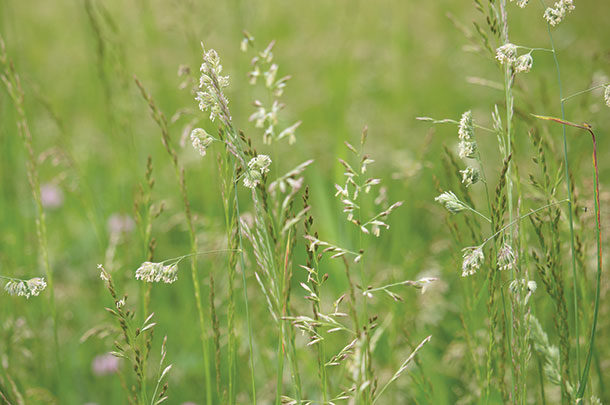Tall fescue is one of the most predominant forage grass species throughout the “Fescue Belt” – middle to southeastern U.S. – and makes up over 10% of the U.S. land area or approximately 37 million acres. According to a USDA survey, approximately one-fourth of all beef cows are located in the Fescue Belt and exposed to endophyte-infected tall fescue. It has been estimated that fescue toxicosis costs the beef industry $2 billion annually with losses related to reduced reproductive and growth performance in cattle.
The good: Quantity and quality of nutrients
In favorable growing conditions, tall fescue is a hardy, deep-rooted perennial that provides good year-round production of quality feed for many livestock species. It may be grazed, harvested for hay or silage, or stockpiled and fed for later consumption, but certain precautions must be taken to prevent negative effects associated with grazing or feeding the forage crop.
Due to its nutrient composition and abundant agronomic traits, tall fescue can be an ideal forage for maintaining and growing livestock, but only if adequate pasture maintenance and proper grazing management procedures are in place.
Quantity of forage produced, whether it is grazed or harvested, is something to consider when deciding on establishing or maintaining a productive forage crop for livestock feed. Tall fescue is a persistent and abundant forage crop with total seasonal production, depending on weather, fertilizer and management practices, yielding 2 to 4 tons of dry matter per acre. In a stockpile-grazing scenario, one acre of an 8- to 10-inch stand of tall fescue will feed approximately 50 to 60 mature beef cows for one day, depending on intake.
Forage nutritive value largely determines animal performance and often is comprised of the concentration of digestible energy, crude protein, minerals and vitamins available. Tall fescue is considered a high-quality forage for beef producers and has been compared to orchardgrass or bromegrass for feed quality.
Crude protein (CP) and digestible-energy concentrations of tall fescue vary throughout the vegetative to boot to mature stages of growth, ranging from 11% to 16% CP and approximately 60% to 65% digestible energy. Calves grazing tall fescue have been estimated to gain between 1.5 to 2 pounds per head per day, depending on intake, based off of National Research Council (NRC) calculations for predicted growth performance. However, calves generally do not achieve gains that high in approximately 85% of the endophyte-infected tall fescue pastures grazed due to the negative effects of fescue toxicosis.
The bad: Ergot alkaloids
The downfall to grazing or feeding tall fescue is the risk of fescue toxicosis caused from plants infected with an endophytic fungal species, such as Neotyphodium coenophialum and Epichloë coenophiala, which lives within plant tissue and aids to improve the tolerance and pest resistance of the plant, but also produces fungal metabolites called ergot alkaloids.
The primary ergot alkaloid produced, ergovaline, is a strong vasoconstrictor, which reduces blood flow by narrowing blood vessels and affects several metabolic functions, resulting in a condition commonly referred to as fescue toxicosis. This condition is characterized by several signs, including increased core body temperature and respiration, reduced feed intake and average daily gain, compromised and failed reproduction, rough hair coats, gangrene of the extremities (also known as “fescue foot”), and bovine fat necrosis, which results in masses of hard fat in the abdominal cavity causing digestive or calving issues.
Fescue toxicosis is a complex syndrome with high variability of toxin concentration and subsequent animal response. Factors such as seasonal or annual fluctuations due to environmental conditions will impact toxin load in the plant. Similarly, genetics, age, stage of production and environmental conditions will determine how animals will respond to the toxin.
However, the two areas where fescue toxicosis has the greatest economic impact on the beef industry is due to reduced reproduction and growth performance.
Approximately three-fourths of the losses associated with fescue toxicosis are related to reproductive failure. Reproductive losses are attributed primarily to early embryonic loss, reduced hormone concentrations and ovarian dysfunction, which leads to reduced pregnancy and calving rates. Research evaluating chronic exposure of ergovaline-induced vasoconstriction of blood flow to the uterus and ovaries is believed to limit hormone signaling and nutrients to the ovaries and impair normal reproductive functions.
The remaining approximate one-fourth of economic losses to the beef industry due to fescue toxicosis is from decreased growth performance in calves. A study evaluating performance in steers grazing high-endophyte pastures across the southern U.S. showed reduced weight gain by more than 50%, and that reduction in growth performance is estimated to cost the beef industry over $500 million annually.
One of the reasons for reduced performance in cattle grazing endophyte-infected tall fescue is that cattle have greater susceptibility to heat stress in warm air conditions due to being less able to dissipate heat and regulate body temperature. This results in an increasing desire for cattle to seek shade or stand in ponds, thus preventing normal grazing behavior and reducing feed intake.
Management strategies
There are numerous publications and resources available that provide guidance to properly manage and utilize tall fescue as an effective forage crop for livestock production. Some key strategies to successfully graze endophyte-infected tall fescue for calves and cows are to be sure you understand the ergot alkaloid concentration with testing, consider converting or reseeding fields with other forages, graze pastures when toxicity is low and work with your nutritionist to determine if a mitigation product is needed.
Collect and submit samples from pastures and harvested or stockpiled hay for analysis to determine levels of ergot alkaloid concentration. Analysis data can provide a better understanding for when and how to utilize pastures and/or feed to reduce the risk of fescue toxicosis. It is recommended to also analyze for other metabolites, including zearalenone (ZEN) and type A and B trichothecenes (including deoxynivalenol or “vomitoxin”) to understand if other prevalent mycotoxins are present and potentially contributing to reduced growth and reproductive performance.
Converting or reseeding endophyte-infected tall fescue pastures with other forages is another strategy to reduce the risk of toxin exposure, but takes time to establish and may increase susceptibility to drought, overgrazing, insects or disease, and total renovation is typically not recommended. However, studies evaluating the cost-effectiveness of using endophyte-free fescue as a replacement in the midwest and southern U.S. was positive. It is recommended to first consult an agronomist to determine if converting or reseeding is a suitable option.
Another common recommendation when grazing and managing tall fescue is to be sure to avoid grazing during summer months, due to increased ergot alkaloid concentration once the plant is able to develop a seed head, affecting palatability and contributing to reduced feed intake.
When a mitigation product is recommended, there are a number of clay and yeast products on the market that can effectively bind (adsorb) mycotoxins, including ergot alkaloids. Many binder products vary in their composition and chemical structure, leading to variability in their effectiveness at adsorbing mycotoxins. However, if other mycotoxins are present and potentially exacerbating or contributing to growth and reproduction performance losses – such as ZEN and trichothecenes – detoxification through enzymatic activity to prevent biological activity of the toxin in the animal is needed, since these toxins are poorly bound.
Conclusion
Given the good and bad traits of tall fescue, there are those wanting to plant or preserve it and there are those who want to get rid of it. Nonetheless, there are good attributes of the hardy crop, such as abundance and nutritive value, while there are the bad anti-quality factors that, when not properly managed, can cause some significant performance losses.









